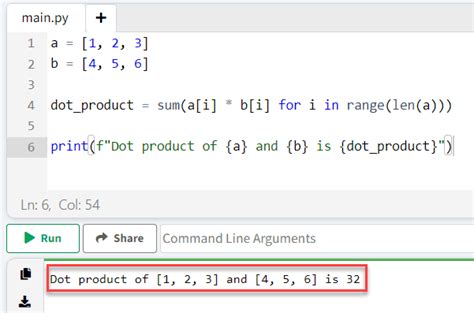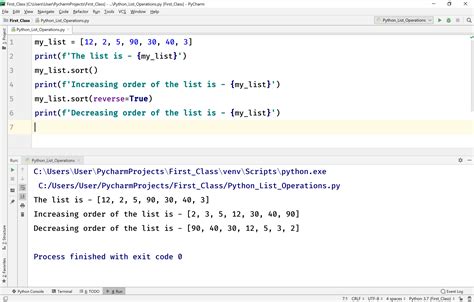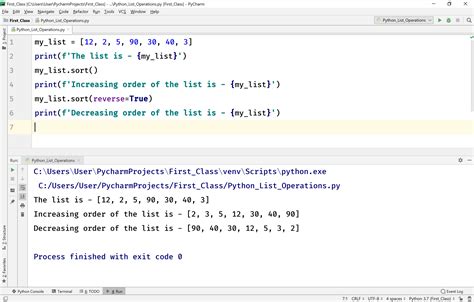Python, a high-level programming language known for its simplicity and readability, offers a wide range of functionalities for data manipulation and analysis. Among its various features, the ability to perform mathematical operations on lists is particularly useful. The `math.prod` function, introduced in Python 3.8, allows for the calculation of the product of all elements in an iterable. This article will delve into five ways to utilize Python's list product functionality, exploring both the `math.prod` function and alternative methods for calculating the product of list elements.
Key Points
- Introduction to the `math.prod` function for calculating the product of list elements.
- Using the `math.prod` function with examples.
- Alternative methods for calculating the product of list elements.
- Utilizing the `numpy` library for product calculation.
- Implementing recursive and iterative methods for list product calculation.
Introduction to math.prod Function

The math.prod function is a built-in Python function that calculates the product of all elements in an iterable. It was introduced in Python 3.8 as part of the math module. This function simplifies the process of calculating the product of list elements, making it more efficient and readable.
Using math.prod Function
To use the math.prod function, you first need to import the math module. Then, you can pass your list of numbers to the math.prod function. Here’s an example:
import math
numbers = [1, 2, 3, 4, 5]
product = math.prod(numbers)
print(product) # Output: 120
This example calculates the product of all elements in the `numbers` list and prints the result.
Alternative Methods for List Product

Before the introduction of the math.prod function, developers used various alternative methods to calculate the product of list elements. These methods include using the functools.reduce function, a loop, or the numpy library.
Using functools.reduce
The functools.reduce function applies a rolling computation to sequential pairs of values in a list. You can use it along with the operator.mul function to calculate the product of list elements.
import functools
import operator
numbers = [1, 2, 3, 4, 5]
product = functools.reduce(operator.mul, numbers, 1)
print(product) # Output: 120
Using a Loop
A simple and straightforward way to calculate the product of list elements is by using a loop.
numbers = [1, 2, 3, 4, 5]
product = 1
for num in numbers:
product *= num
print(product) # Output: 120
Using numpy Library
The numpy library provides a function called prod that can be used to calculate the product of array elements.
import numpy as np
numbers = np.array([1, 2, 3, 4, 5])
product = np.prod(numbers)
print(product) # Output: 120
Recursive and Iterative Methods
Besides the methods mentioned above, you can also calculate the product of list elements using recursive and iterative approaches.
Recursive Method
A recursive function calls itself until it reaches a base case that stops the recursion.
def recursive_product(numbers):
if len(numbers) == 1:
return numbers[0]
else:
return numbers[0] * recursive_product(numbers[1:])
numbers = [1, 2, 3, 4, 5]
product = recursive_product(numbers)
print(product) # Output: 120
Iterative Method
An iterative approach uses a loop to iterate over the list and calculate the product.
def iterative_product(numbers):
product = 1
for num in numbers:
product *= num
return product
numbers = [1, 2, 3, 4, 5]
product = iterative_product(numbers)
print(product) # Output: 120
| Method | Description | Example |
|---|---|---|
| `math.prod` | Calculates the product of all elements in an iterable. | `math.prod([1, 2, 3, 4, 5])` |
| `functools.reduce` | Applies a rolling computation to sequential pairs of values in a list. | `functools.reduce(operator.mul, [1, 2, 3, 4, 5], 1)` |
| Loop | Iterates over the list and calculates the product. | `product = 1; for num in [1, 2, 3, 4, 5]: product *= num` |
| `numpy.prod` | Calculates the product of array elements. | `np.prod([1, 2, 3, 4, 5])` |
| Recursive | Calculates the product using a recursive function. | `recursive_product([1, 2, 3, 4, 5])` |
| Iterative | Calculates the product using an iterative approach. | `iterative_product([1, 2, 3, 4, 5])` |

Conclusion
In conclusion, Python offers various methods for calculating the product of list elements, including the math.prod function, functools.reduce, loops, the numpy library, and recursive and iterative approaches. Each method has its own advantages and use cases, and the choice of method depends on the specific requirements of the project. By understanding these different methods, developers can write more efficient and effective code.
What is the math.prod function in Python?
+
The math.prod function is a built-in Python function that calculates the product of all elements in an iterable. It was introduced in Python 3.8 as part of the math module.
How do I calculate the product of list elements using a loop?
+To calculate the product of list elements using a loop, initialize a variable to 1 and then iterate over the list, multiplying the variable by each element.
What is the difference between the recursive and iterative methods for calculating the product of list elements?
+The recursive method uses a function that calls itself to calculate the product, while the iterative method uses a loop to iterate over the list and calculate the product. The recursive method can be less efficient and more prone to stack overflow for large lists, while the iterative method is generally more efficient and scalable.
Related Terms:
- python product of list
- Python product of two lists
- Python prod of list example
- Python multiply list by scalar
- Python itertools product
- Python list product itertools
